Bulk-generate & schedule posts in seconds with Smart Scheduling. Try now!
Content Pillars: A Game-Changer for Your Social Media Strategy

Content pillars is a fancy word for content categories or content clusters. It’s an essential content development strategy to build “authority” and “relevance” in the industry.
Most of you have heard about TOPICAL AUTHORITY – it’s a widely used term in modern-day SEO. The topical authority is established by covering a category or niche in full by a website. As a result, the search engines start to look at the website as an authority in that space.
Content pillars are used to build topical authority in the SEO and blog publishing area. The SEO experts or digital marketers go all in with publishing articles or uploading videos on a specific category to appear as an authority.
Since content creation and social media go hand-in-hand, it’s vital to understand how content pillars impact the social media strategy.
Simplified social media marketing for individuals & agencies.
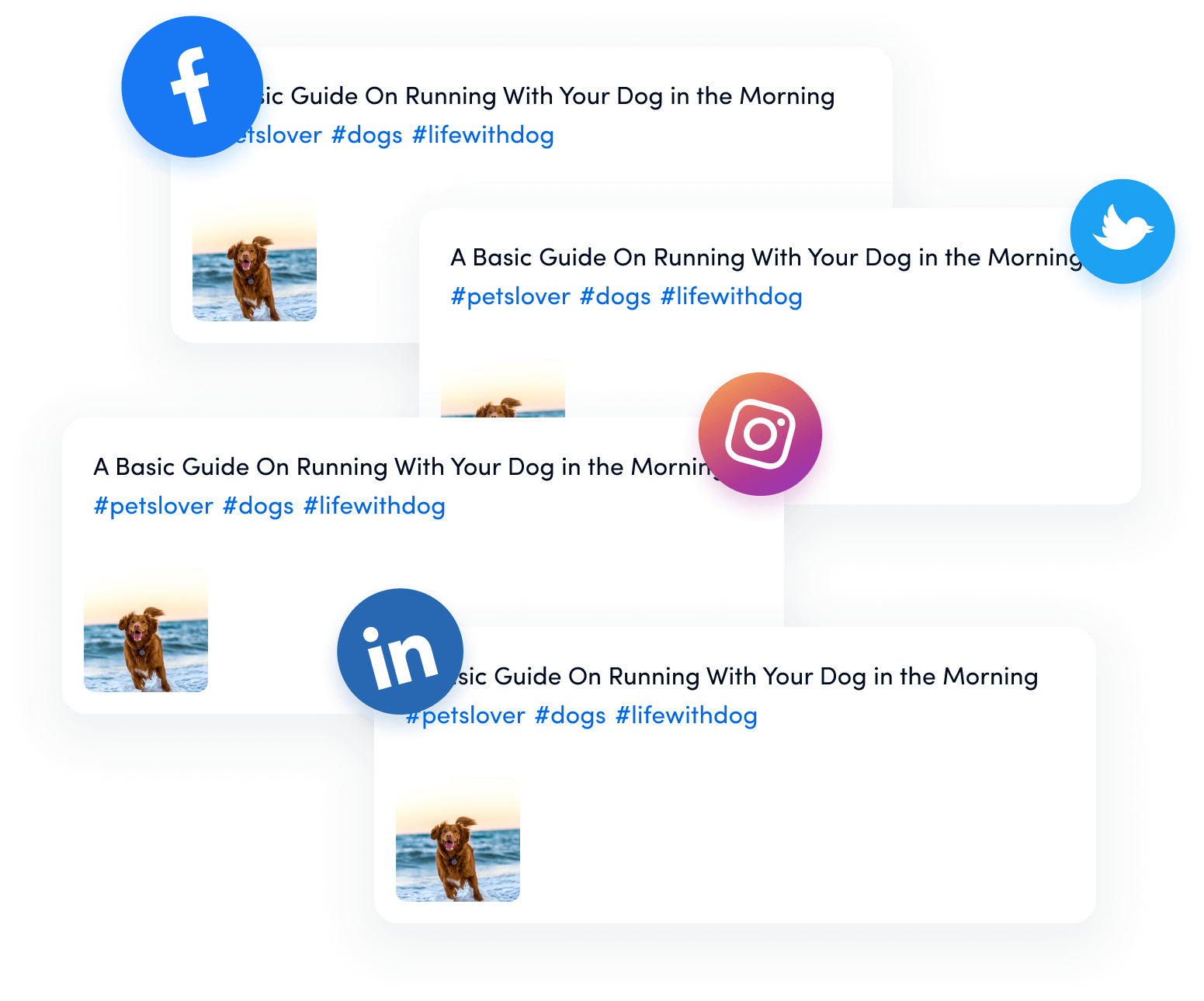
Let’s dive deep into the topic and figure out its implications.
But you must first comprehend social media content pillars and their relevance to your social media strategy.
What are social media content pillars?
Social media marketing is much more than content publishing, social scheduling, and social content insights.
To get the full picture, it’s necessary to understand the jargon being used or the concepts map being discussed in the industry.
Social media content pillar is a buzzword widely used in the social media industry for discussing, addressing, and improving content relevance.
The social media content pillar refers to the combination of multiple relevant topics that a brand focuses on for creating social media content and to become a prominent voice in the space.
Usually, most brands like to include three to five relevant topics, or they have the command to talk confidently.
For instance, an online publication on mental health could have content pillars on self-help, well-being, mind management, and meditation.
So basically, social media content pillars are social content categories that a brand wants to plunge into to help the audience, attract prospects, and convert fans into paying customers.
What are the different types of content pillars?
Content pillars are key in SEO as they fuel brands’ search engine marketing efforts. To understand the types of content pillars, simply analyze the types of content a website or blog publishes.
Most SEOs and content marketers use the standard content pillar types that include but are not limited to how-tos, complete guides, listicles, comparison posts, and product reviews.
Let’s elaborate on these types of content pillars:
- How-to tutorials
How-to articles are tutorial blog posts that share the fundamentals of the process and educate the readers on a certain topic.
These types of content pillars are intended to educate both basic and advanced readers. There are two main reasons for publishing the how-to articles:
- In most cases, how-to articles are important to publish for the silo structure of the blog content. They support the overall content strategy of the publication.
- In some cases, how-to articles are necessary to help guide the readers, especially if advanced content is planned for the future.
It’s not rocket science; you’ll see how-to articles on almost every content website or official blog that publishes content for SEO and content marketing.
Example: ContentStudio Blog
ContentStudio is an all-in-one social media management dashboard for marketers, small businesses, agencies, and organizations.
Take a look at their official blog; they publish how-to guides from time to time:
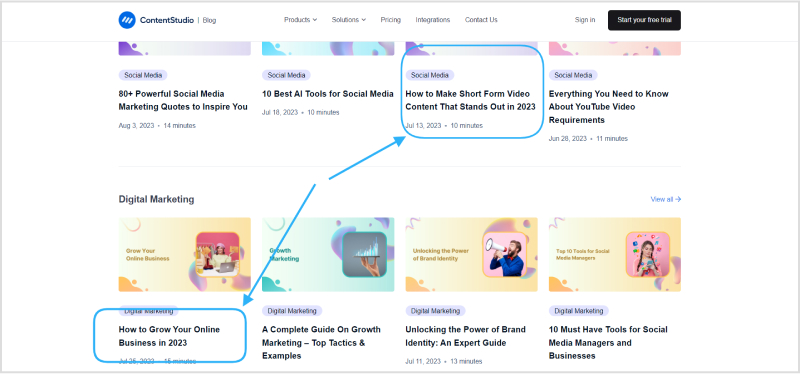
It tells us how important the how-to content pillar is for any publication or blog.
- Complete guides
Complete guides are an essential type of content pillar. These are usually long-form guide articles that are written to discuss, educate, and guide the audience.
The purpose of this content pillar is to cover the topics in depth and provide detailed guidelines to help readers navigate through the specific process.
Unsurprisingly, bloggers, SEOs, digital marketing agencies, and social media experts publish complete guides on their industry-related topics to attract and engage the audience.
Related Read: How Agencies Collaborate on Content Marketing Ideas?
Example: Replug blog
Replug is a powerful URL shortener tool that provides users a complete link management suite.
Check out their official blog; they often publish complete guides on their relevant topics:
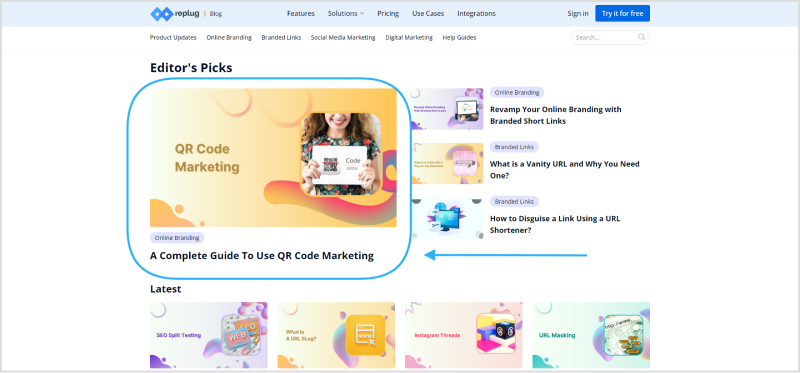
- Comparison posts
Comparison posts are two or more product analyses to showcase which looks better. Sometimes, comparison posts are a first-look overview of two or more products.
It doesn’t matter how a comparison blog post is titled — whether it’s product A vs. product B or a top five products list — the purpose is to compare products with each other.
Mostly, it’s a head-to-head comparison of two products to see which product is ahead of the other. However, marketing experts and pro-bloggers also compare more than two products.
Example: Blogging Wizard
Blogging Wizard is a popular blogging tips blog that teaches people how to run a successful blog and make money blogging.
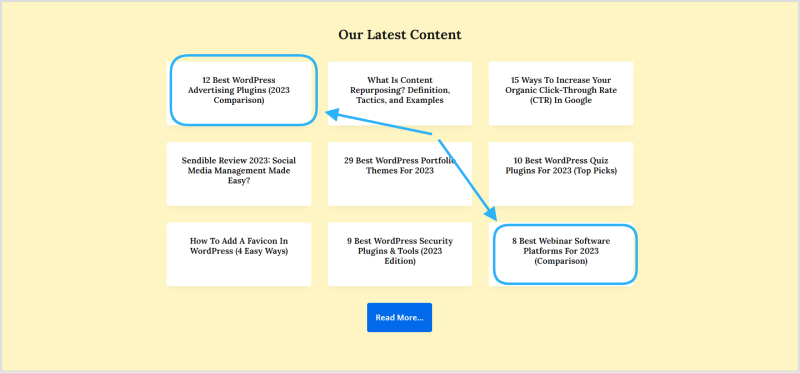
The team at Blogging Wizard knows the importance of comparison posts and often compares two or more products.
- Listicle posts
Listicles or list posts are a major type of content pillar. Almost every blogger publishes listicles on the blog.
One of the reasons why listicles are so popular is that it gives a list of products or services to explore without wasting much time.
On the flip side, the readers might have to scroll through the search engine results and check out dozen of blog posts to find the top two or three product options.
The listicles are more of a direct answer or recommendation from the industry expert. Therefore, utilizing this type of content pillar on your blog is vital.
Example: Usermaven
Many SAAS companies, software agencies, and digital marketing companies publish listicles to attract prospects and get their content discovered through search.
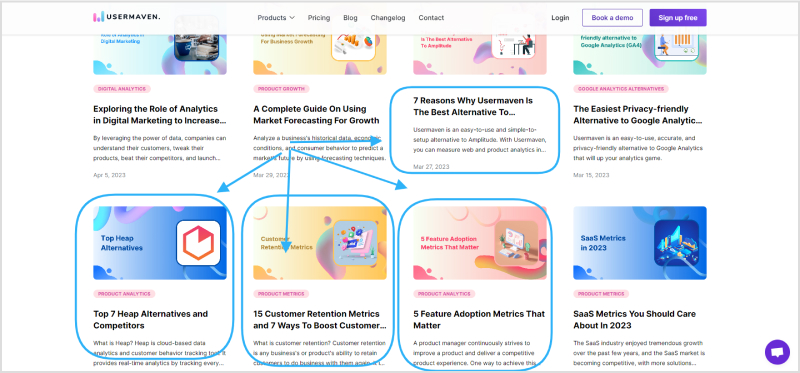
The team at Usermaven knows this secret. No wonder they have been this listicle’s strategy on their official blog.
- Question-based posts
Question-based posts are a type of informational blog post that answer the searcher’s query rather quickly. Mostly, these types of blog posts aren’t in-depth and long. Instead, they are usually 1,000 to 1,500 words long.
This type of blog post could turn out to be very useful from the organic traffic standpoint since they are written with the searchers’ queries and pain points in mind.
It’s not a made-up tactic. In fact, many top-tier marketing agencies, software companies, and SAAS tools publish question-based blog posts to attract prospects and assist existing customers.
Example: Semrush Blog
Semrush is a well-known keyword research and website tracking tool. They have been pushing hard on their official blog for years. Undoubtedly, they have one of the best blogs in the digital marketing space.
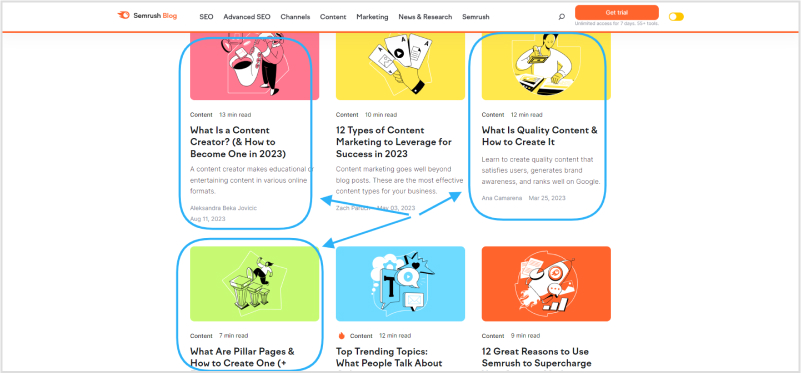
They have been publishing question-based blog posts for a long time, which validates my point.
- Product reviews
Product reviews are an important blog monetization strategy. Probloggers and digital marketers review the products they promote and earn commissions through referrals.
More importantly, product reviews are an essential blog content type that directly influences the bread and butter of the blogger.
This makes product reviews a vital content pillar to pay close attention to when establishing a blog, no matter the niche.
All major blogs review products and services to not just help their audience but also to make money off of their blogs.
Example: Smart Blogger
Smart Blogger is a highly regarded blog in the “profitable blogging tips” genre.
Just like any other blog, the team at Smart Blogger also reviews products. Take a look at the screenshot below:
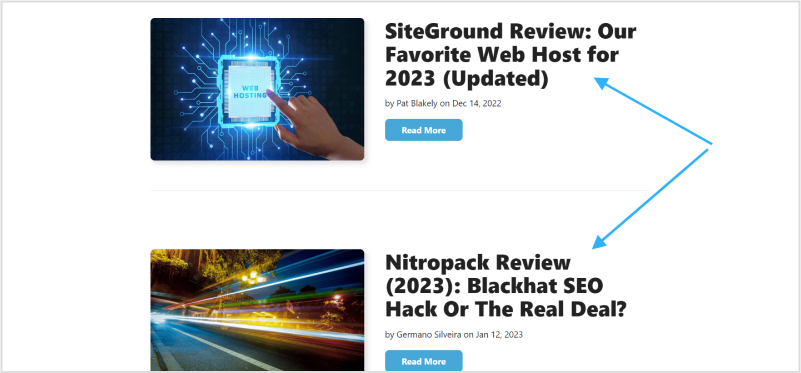
That’s it.
These were some of the content pillars that brands, small businesses, and bloggers must keep an eye on when creating blog content.
Why are content pillars important in social media strategy?
Content pillars contributing to a brand’s SEO growth are essential to the content plan. Most brands and entrepreneurs want to create a mix of different content pillars to see which ones outperform the rest.
One of the reasons why brands pay close attention to building, improving, and analyzing their content pillars is that they impact the overall social media content performance.
Plan, schedule, share, and analyze content for 15+ social media channels.
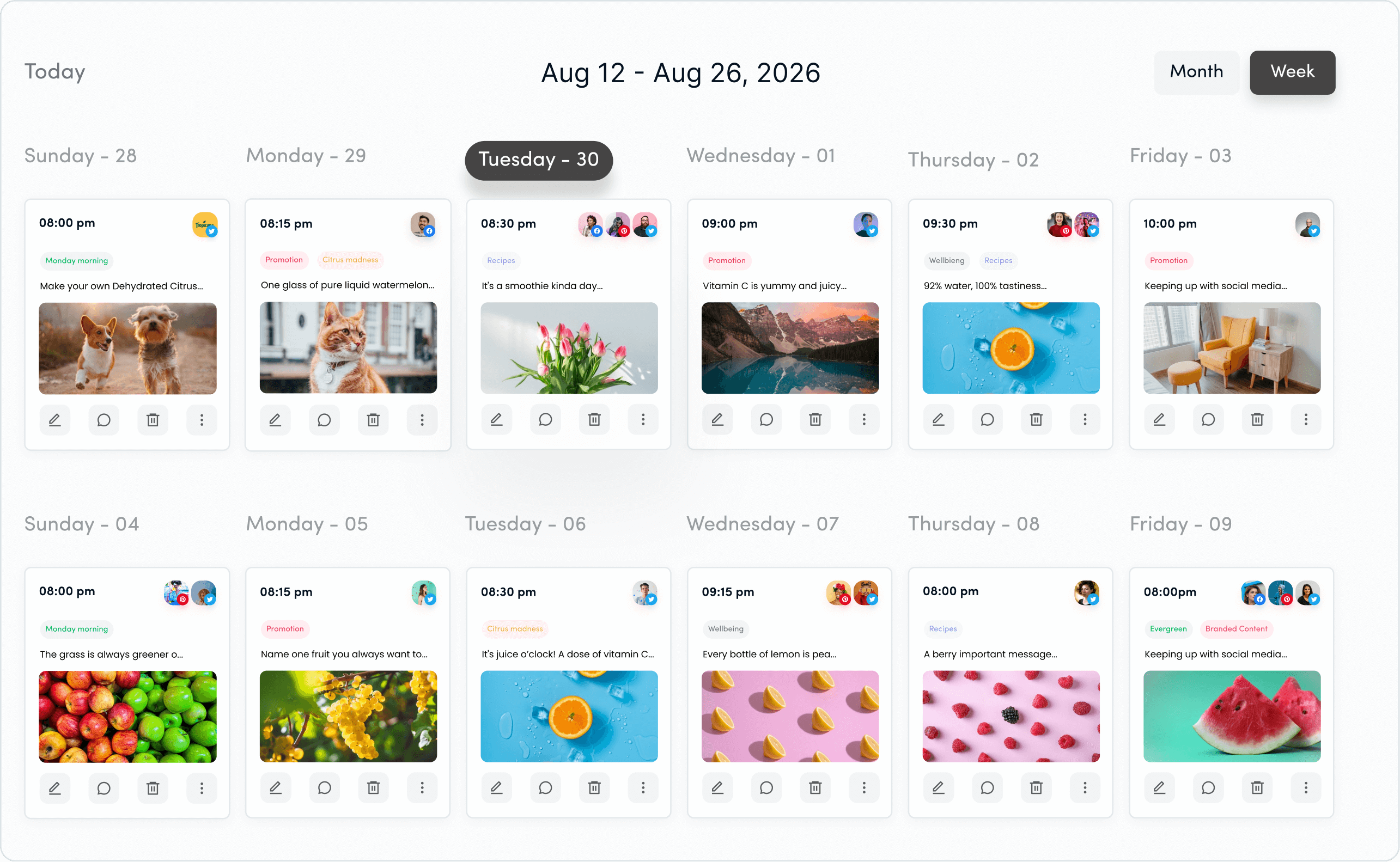
Let’s shed some more light on the importance of content pillars in the social media realm and try to understand how content pillars influence social media growth:
1. Provide a sense of direction to the social media team
It gets easier to map out the whole social media pathway when there are content buckets to work on.
Most brands have at least five or more content categories on their blogs, which serves the purpose. Even though content pillars are the types of content being published on the blog, the content categories help readers understand the intent behind the publishing.
When content pillars are pre-defined in the content plan, it becomes easier for the social media team to create a social media publishing strategy for the brand. However, creating a balance between all content pillars is vital when establishing a social media strategy.
2. Help brands reach a wider audience on social media
Since content pillars add variety to the content plan, they help brands reach a bigger circle. The perk of experimenting with different content pillars is widening the brand’s targeting spectrum.
If a brand continues to publish a specific type of content and it doesn’t bring much attention to the brand, then trying a different content pillar is the way to go.
Unsurprisingly, brands often try out different content pillars and analyze the outcome on social media to see what type of content gets the most clicks and conversions.
3. Unlock more engagement opportunities for the marketing team
More content pillars mean more content across different categories. It essentially put more flesh on the bones, especially when the content is good and worth sharing on social media.
It’s safe to say that the brands that consistently put out good-quality content outperform those that rarely share content on social media.
The point is that having relevant yet meaningful content pillars brings more engagement opportunities for the sales and marketing team.
Also Read: Social Media Engagement: 10 Easy Ways to Improve it
Social Customer Service Never miss a message or comment from your social media audience. Try ContentStudio’s Inbox.
4. Assist in figuring out what the audience likes the best
One of the important factors of content pillars is that it gives you an idea of the audience’s taste. The performance analysis gets interesting when multiple types of content are on the blog.
The content team could dive deep into the analytics and see which types of articles are doing good in search engines and which ones get the most shares and mentions on social media.
When you’re publishing a single type of content, you won’t know what other types of content would do on your blog unless you try it out.
So these were four of the many reasons why it’s important to use content pillars and embed them into your social media marketing strategy.
How to define and come up with content pillars for your brand
Every brand has a unique perspective on building relationships with the audience. The communication of the brand with the prospects and customers speaks for itself. It is reflected in content, social media engagement, and customer support.
Read Up: The Secret of Social Media Management: Making Your Audience Better
Building an effective content strategy is the essence of delivering value to the audience and prospective customers. Content pillars are crucial to developing a value-driven content policy that takes a brand’s relationship with a customer to the next level.
Here are five key elements to remember when coming up with content pillars for your brand:
1. Brand values
Brand values are a major key to determining the content pillars for your brand. Usually, brand values are a belief system that companies communicate through their brand marketing, advertising, mission statements, marketing slogans, and promotional material.
Related Read: Unlocking the Power of Brand Identity: An Expert Guide
2. Relevance
Relevance is crucial to establishing a powerful content marketing plan for a brand. Relevance in the content pillar selection means determining the type of content that appeals to the specific audience.
3. Strengths
Strengths are the strong areas of a brand. Creating content based on strengths is always better than creating content based on guesswork. Remember your brand’s strengths when creating content pillars because they will lay the foundation for your brand’s social media marketing strategy. P.S. Ever wondered which is better for your brand’s strategy: Instagram Vs. Facebook?
4. Positioning
Positioning in branding and marketing means how a brand is perceived in the prospects and customers’ minds. It’s an essential factor in establishing a content pillar. Defining the right content pillars for the brand helps create brand positioning that would last for a long time.
Also Read: 10 Social Media Branding Tips for Brands in 2023
5. Roadmap
One of the important aspects of coming up with the content pillars is to set a roadmap for your social media content marketing. When content pillars aren’t pre-defined, the content strategy goes everywhere. Moreover, a pointless content strategy is a road to getting burned out and ending up frustrated.
These are five key elements to remember when establishing the content pillars for your brand.
Create your social media content strategy using content pillars
Building a relevant and authentic content marketing strategy is crucial to success, whether you’re an SEO-driven business or following a social media-oriented marketing strategy.
Related Read: How to Build a B2C Social Media Marketing Strategy for Your Business
Content pillars help brands, marketing agencies, and blogs implement their SEO growth tactics and achieve success.
Follow the steps mentioned below to navigate the process of creating a compelling social media content strategy using the power of content pillars:
1. Understand what your audience wants
There is no better content strategy than understanding what your audience struggles with and providing them with solutions.
It doesn’t mean sleeping on keyword research, SEO strategy, and social media engagement. In fact, understanding your audience means utilizing all these channels at their core. Go an extra mile. Pay more attention than ever.
Also Read: The Secret of Social Media Management: Making Your Audience Better
In today’s technology and social media age, several ways could be used to understand your needs or wants.
Here are the mediums to pay close attention to when trying to figure out what people want to know:
- Surveys: You can always survey your audience to find out what they have been struggling with. Use your email list or social media platform to do this.
- Emails: Keep an eye on email queries, especially if you’re a brand. Repeated customer queries help us determine what the audience wants to know more about.
- DMs: Direct messages on Instagram, Facebook, and other social media platforms give us a hint about the problem the audience is facing. Pay attention to those questions in the DMs. Conversely, are you looking for short bio examples to impress your audience?
- Comments: All comments aren’t always trash on social media. Keep an eye out for the comments to understand what people are talking about, and try to cherry-pick the good ones to answer through your social media content.
Take a look at this tweet:

Jamie is a blogger and affiliate marketer. He knows how to use Twitter. Not only does he share his thoughts, but also likes to pick followers’ brains on the relevant topics.
Related Read: How to Make Money with Affiliate Marketing
2. Hand-pick the right social media platforms
One of the honest mistakes you can make is hopping on a dozen social media platforms and trying to dominate them all at once. It’s not going to happen. You aren’t going to make it happen this way.
Instead, try to pick one or two social media platforms, especially the ones where you can publish the same content. For instance, you can post the same video on TikTok and Instagram Reel.
Ensure you aren’t getting burnt out by keeping up with your two or three social media platforms. It has to be fun; otherwise, you won’t be able to do it long-term.
Since you will use the existing content pillars from your blog to create social media content, it won’t be a tiresome process to figure out what needs to be published on social media.
Simply keep the number of social media channels to a minimum.
Here’s an example:

Sam and Monica are YouTuber influencers. They create cheeky and fun YouTube short videos around their married life and romance.
They have found Shorts as their go-to vertical on social media, and they’re surely crushing with it.
3. Build a social media content plan
A social media content plan means a roadmap to publish content across all of your social media platforms. In other words, it’s a list of topics you will discuss on social media.
It doesn’t matter what type of content you intend to use your content pillars because the more you create, the higher the reach.
Social Media Content Calendar Stay consistent and organized with Contentstudio’s social media content calendar for marketers and agencies.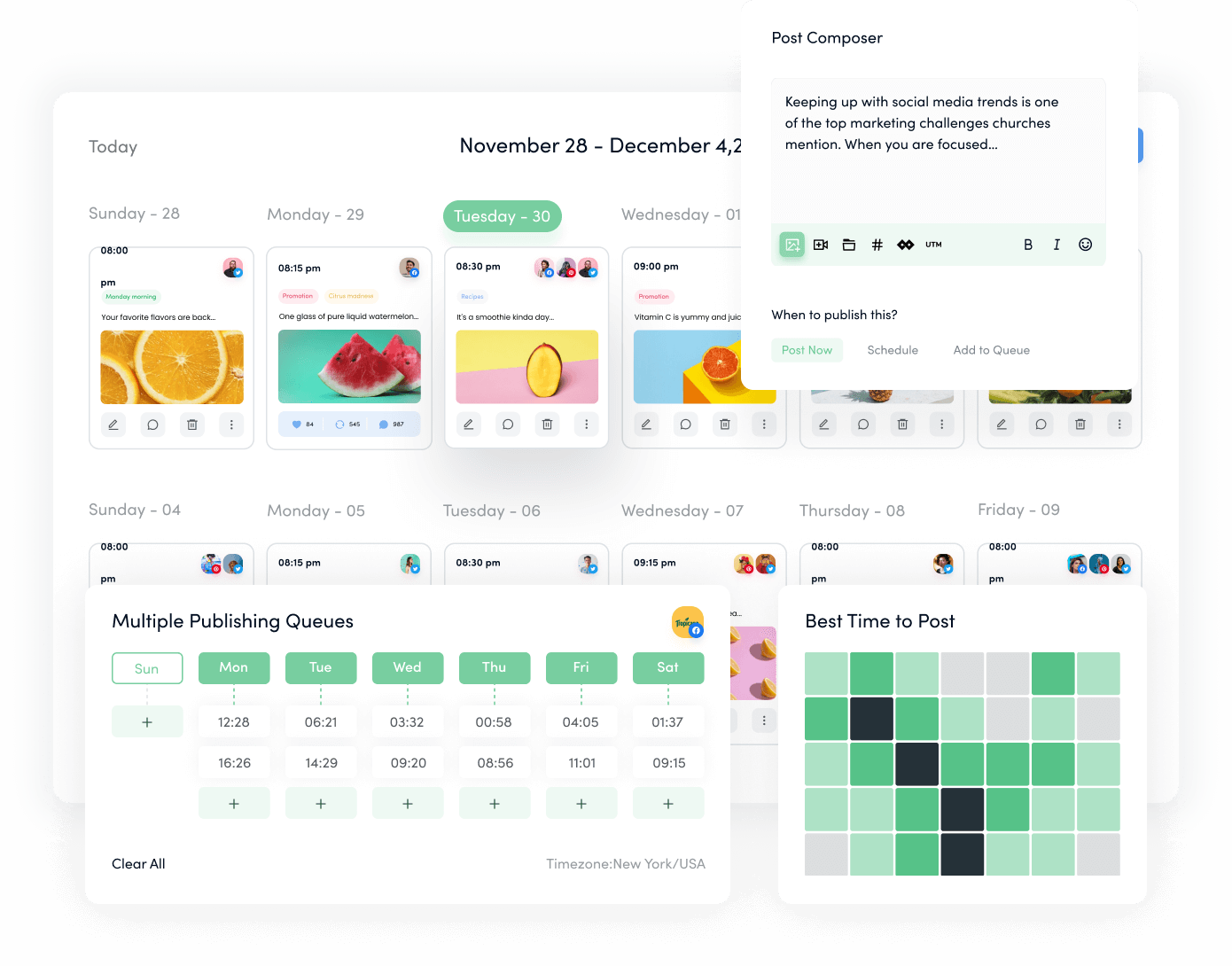
Here are different social media content formats you can work on:
- Reels/Shorts/TikToks (But, Instagram Reels Vs. TikTok: Which is Better for Content Marketing?)
- YouTube videos
- Infographics
- Audio podcasts
- Instagram posts
- Pinterest pins
- Text/Image tweets
It gets easier to navigate when you’re building your social media content strategy using your existing content pillars. No need to do new customer research, keyword analysis, and content engagement analysis.
All you need to do is to get on with your content pillars from the blog and streamline your social media content plan for publishing.
You can take one of the two social media content creation approaches:
- Hand-pick the top-performing articles and use the topics to create social media content
- Create social media posts across the board; use every article to make social media posts
The key to building social media content is to develop a sense of awareness about what your followers might be interested in. The best way to find out is to look at the data and insights of your social media content.
Once you tap into the analytics and figure out what’s working for you, building a social media content plan won’t be a problem.
Brian Dean is a blogger, entrepreneur, and SAAS builder. He built and sold Backlinko for a mid-7-figure. Now he is building Exploding Topics. It’s a SAAS tool that monitors the upward trending topics in search.
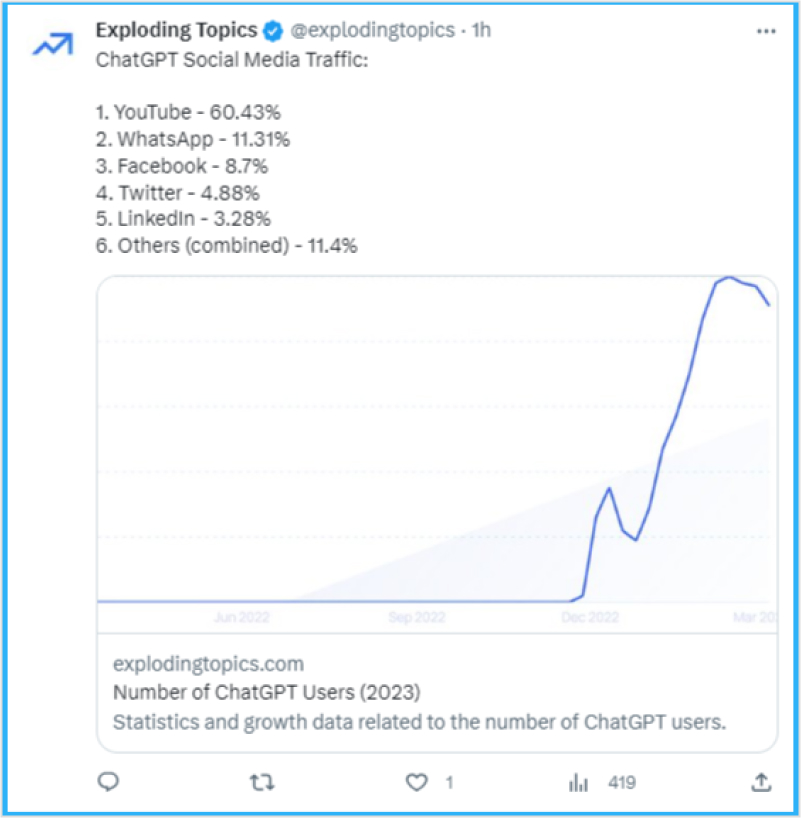
Exploding Topics has a simple yet effective social media content plan. Since this startup is huge on Twitter, they’re smartly using the brief overview of the articles and graph-based images, driving a ton of traffic to their blog posts.
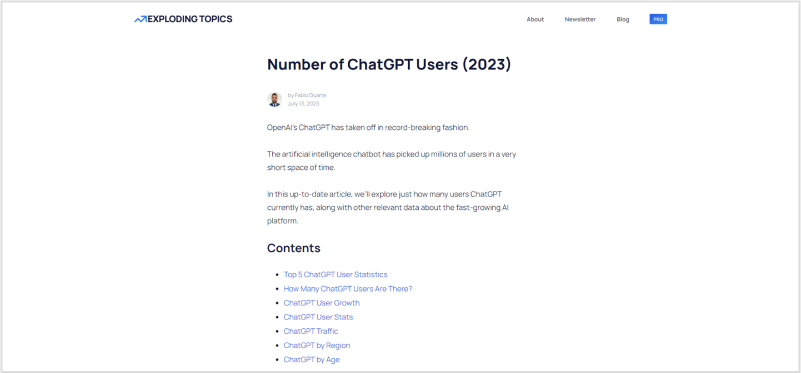
When the readers land on the blog, they see an email newsletter opt-in screen.

So they’re checking three boxes with their social media content strategy.
4. Choose a social media management tool
An easy-to-use, affordable, and comprehensive social media management tool goes a long way. Creating a social media marketing strategy without capitalizing on a social media scheduling tool is nearly impossible.
The reason is scalability – if you don’t have a social media scheduler, think again.
Read Up: Top 28 Social Media Management Tools for 2023
Your competitors might be scheduling social media content for the next week or so and putting most of their time into researching new topics. On the other hand, you spend half an hour daily publishing one social media post across different social media platforms – it’s not a great approach to beat your competition this way.
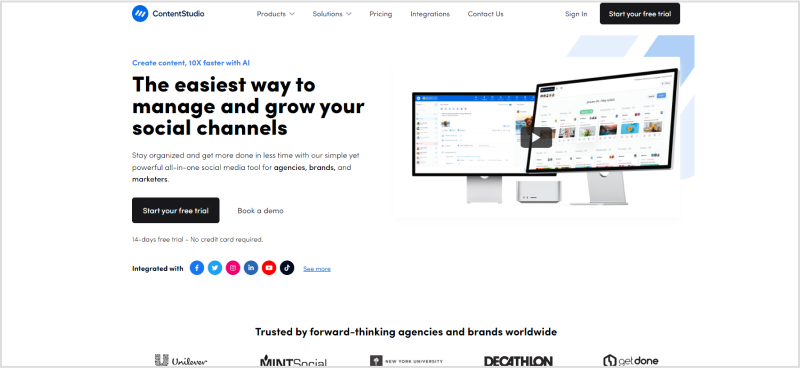
ContentStudio is an all-in-one social management tool with AI integration that helps you curate, schedule, discover, and analyze social media content. Sign up for a 14-day free trial.
Here are some benefits of ContentStudio:
- Lets users schedule social media content across different social media platforms
- Allows publishing/scheduling on blogging platforms
- Gives access to analytics for social media content
- Creates AI-powered social media captions, hashtags, and images
- Makes team collaborations easier for effective communication
- Provides workflow approvals for seamless automation and publishing
- Helps plan social publishing via the content calendar
- Assists brands with influencer research through discovery feature
These were some of the perks of using this social media dashboard.
ContentStudio is an award-winning social media management tool with over 120,000 users worldwide.
No social media content strategy can perform to the fullest until a reliable, effective, and trusted social media scheduling tool is available at the team’s disposal. So choose your social media scheduling tool wisely.
5. Create a content calendar for your brand
A social media content calendar isn’t rocket science. It all begins with understanding your brand’s strengths and utilizing them to create great content that hits the bullseye.
Content pillars assist the social media team develop a social media content plan for the brand. Once the social media content plan is in place, creating a social media content calendar is no issue. All you need to do is to pick an excellent social media content planner for this task. P.S. Have you heard of the Instagram feed planner to create a stunning Instagram feed?
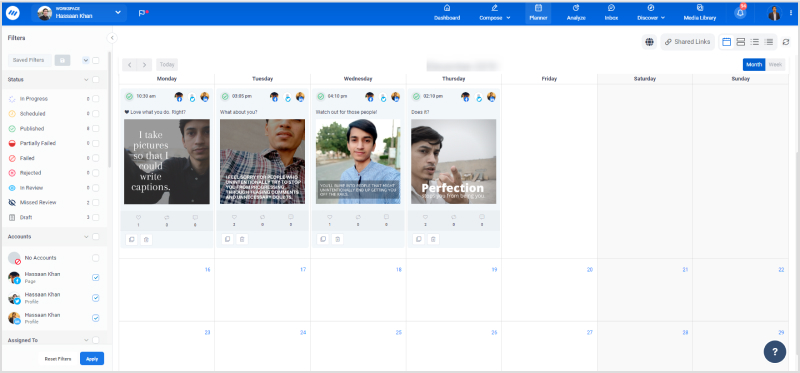
It’s a shameless plug, but I love ContentStudio for many reasons. It has a content calendar feature that lets users create a complete social media content calendar without much hassle.

The content calendar section has several filters to analyze content performance. These filters include:
- Status: It showcases the total numbers of scheduled, published, in-progress, in-review, failed, rejected, and partially failed social media posts in the ContentStudio workflow.
- Accounts: It displays all the linked social media to the ContentStudio account.
- Assigned to: The section reports on the team members and the social media posts assigned to them.
- Created by: It’s the option to find out the posts from a specific team member; it tells who created the social media posts.
- Content type: This feature unveils different types of posts published through the account, for instance, repeat posts, article automation posts, evergreen automation posts, etc.
- Campaign folder: This is the option to see the campaign folder for social media posts.
- Content categories: Use this filter to find out the content categories for the social media posts.
Therefore, it’s safe to say that creating a content calendar hasn’t been this easier.
6. Analyze your social media metrics over time
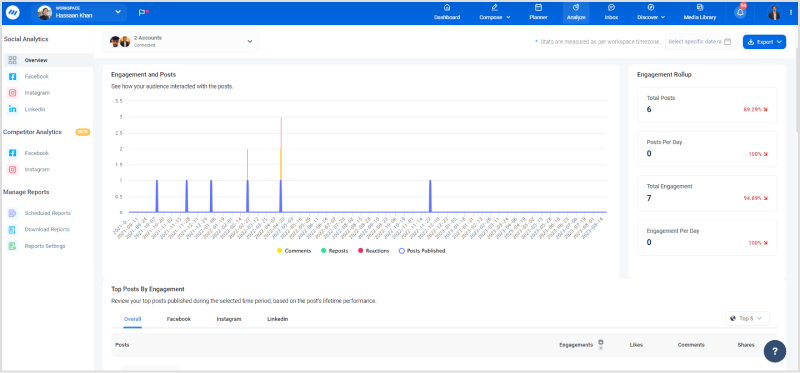
One of the essential steps in building high-performing content pillars is to analyze the performance of your social media content.
ContentStudio has got your back – thanks to the Analyze section.
A powerful social media management tool always has an in-depth reporting feature that allows social media users to dive deep into their social media content analytics.
The data and analytics provide insights into the social media content – the users could learn about their content engagement, clickability, conversion, and other performance indicators.
So don’t overlook your social media content metrics when building a social media content strategy using the content pillars.
FAQs about building a social media content strategy using content pillars
Let me answer some of the common questions in this regard:
What are the 5 content pillars?
Every brand has different content pillars to focus on, but the usually the following ones are quite common:
- Reviews
- Round-ups
iii. Listicles
- How-to guides
- Case studies
What are the types of content pillars?
Different types of content pillars include product reviews, how-to guides, comparison posts, listicles, and product round-ups.
What is the purpose of content pillars?
The main purpose of the content pillars is to develop relevance, authority, and trust with the readers and search engines. It showcases how in-depth and relevant the content is on the website.
Recommended for you
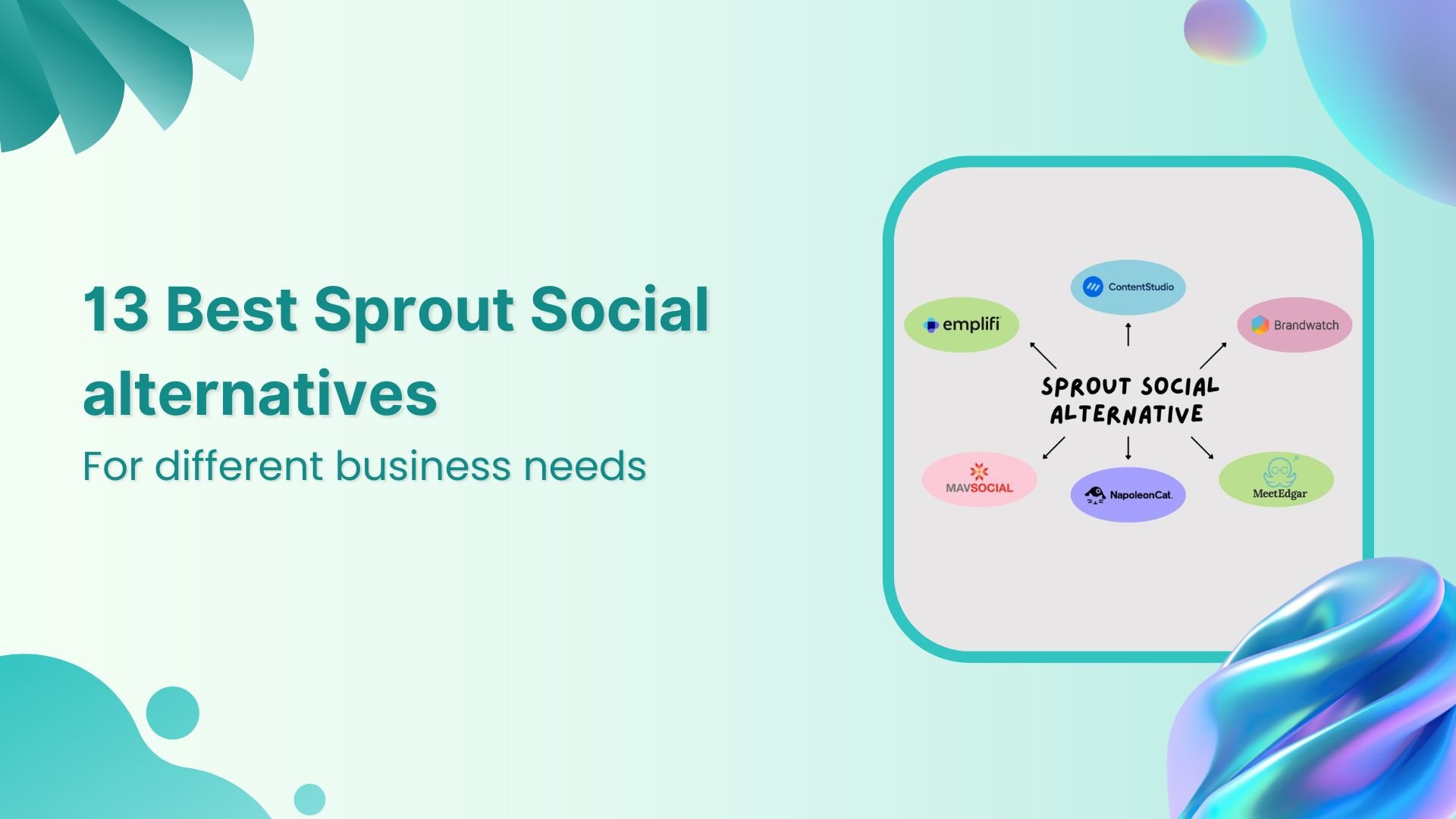
13 Best Sprout Social alternatives for effective social media management
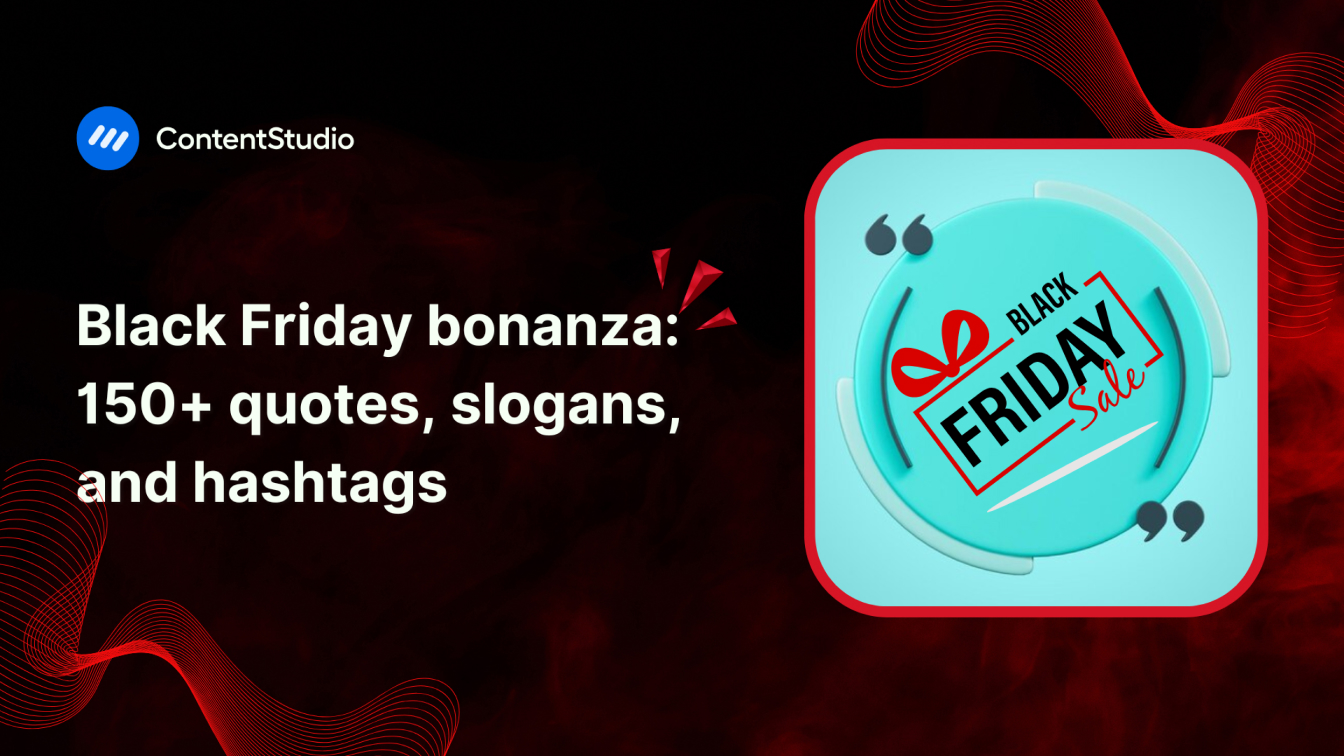
150+ Black Friday quotes, hashtags, and slogans to boost sales

Why is an integrated marketing campaign beneficial for your brand?


Powerful social media management software
14-day free trial - No credit card required.
